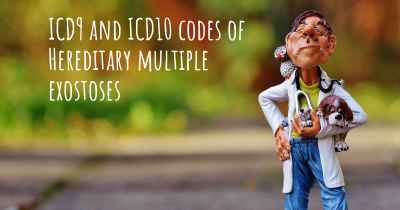What is the history of Hereditary multiple exostoses?
When was Hereditary multiple exostoses discovered? What is the story of this discovery? Was it coincidence or not?

Hereditary multiple exostoses (HME), also known as multiple osteochondromas, is a rare genetic disorder characterized by the development of multiple benign bone tumors called osteochondromas. These tumors typically grow near the growth plates of long bones, such as the femur, tibia, and humerus. HME is an autosomal dominant disorder, meaning that an affected individual has a 50% chance of passing the condition on to each of their children.
Historical Background:
The history of Hereditary multiple exostoses dates back to the late 19th century when it was first described by German orthopedic surgeon Wilhelm Conrad Roentgen in 1891. Roentgen, who later won the Nobel Prize in Physics for his discovery of X-rays, observed the presence of multiple bony outgrowths in a patient's skeleton during a routine examination. He named these outgrowths "exostoses" and recognized their hereditary nature.
Early Research and Classification:
Further research on Hereditary multiple exostoses was conducted by other prominent physicians and scientists in the early 20th century. In 1901, German orthopedic surgeon Friedrich Pauwels classified the condition into two types based on the location of the exostoses: juxtacortical (near the bone surface) and central (within the bone). This classification system is still widely used today.
Genetic Discoveries:
In the 1990s, significant progress was made in understanding the genetic basis of Hereditary multiple exostoses. Researchers identified two genes, EXT1 and EXT2, that are responsible for the majority of cases. These genes encode proteins involved in the synthesis of heparan sulfate, a molecule essential for normal bone growth and development. Mutations in the EXT1 and EXT2 genes disrupt the production of heparan sulfate, leading to the formation of osteochondromas.
Clinical Features and Diagnosis:
Individuals with Hereditary multiple exostoses typically develop multiple osteochondromas during childhood or adolescence. These bony outgrowths can cause various complications, including skeletal deformities, limb length discrepancies, joint stiffness, nerve compression, and reduced range of motion. Diagnosis is usually made based on clinical evaluation, family history, and imaging studies such as X-rays and MRI scans.
Treatment and Management:
There is currently no cure for Hereditary multiple exostoses, and treatment focuses on managing symptoms and preventing complications. Regular monitoring of osteochondromas is essential to detect any malignant transformation, although this is rare. Surgical removal may be necessary if the tumors cause significant pain, functional impairment, or nerve compression. Physical therapy and orthopedic interventions can help improve joint mobility and correct skeletal deformities.
Current Research and Future Directions:
Ongoing research aims to further elucidate the molecular mechanisms underlying Hereditary multiple exostoses and develop targeted therapies. Scientists are investigating potential gene therapies, such as gene editing or gene replacement, to correct the genetic mutations responsible for the condition. Additionally, advancements in imaging techniques and biomarker identification may improve early diagnosis and monitoring of disease progression.
Conclusion:
Hereditary multiple exostoses is a rare genetic disorder characterized by the development of multiple benign bone tumors. Its history dates back to the late 19th century when it was first described by Wilhelm Conrad Roentgen. Significant progress has been made in understanding the genetic basis of the condition, with the identification of the EXT1 and EXT2 genes. While there is currently no cure, ongoing research offers hope for improved treatments and management strategies in the future.
Posted Nov 30, 2017 by Zahra 1950








